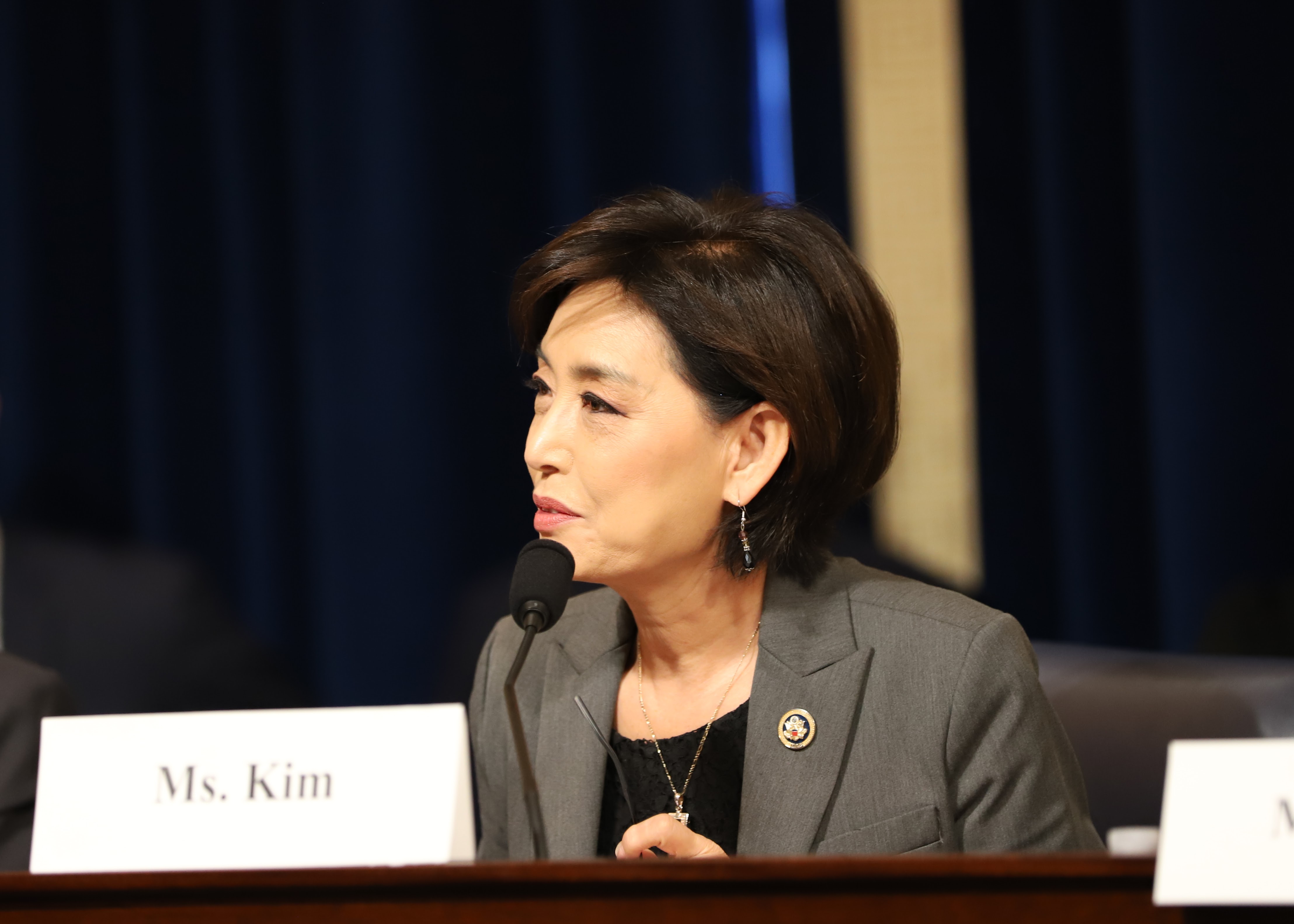The two local Republicans who represent portions of Orange County in the House haven’t tweeted “voting rights” or “LGBTQ” even once from their official accounts since the start of the Congressional session in January 2021, while most local Democrats have never mentioned “gas prices” and none have tweeted “rising crime.”
Rep. Linda Sanchez, D-Whittier, has tweeted “insurrection” 12 times but she’s never tweeted “inflation.” Meanwhile, Rep. Michelle Steel, R-Seal Beach, has tweeted “Kobe Bryant” 11 times but never “climate.” And Rep. Lou Correa, D-Anaheim, is the only local House member who’s tweeted “cannabis” this session.
It can sometimes feel as though politicians on opposite sides of the aisle are speaking different languages. And a Register analysis of all 8,318 tweets the seven local Congress members have sent so far this session shows some clear distinctions in their use of particular words and phrases even when discussing related topics. For example, when talking about economics, one of the words that appears most often in official tweets from Rep. Young Kim, R-La Habra, is “businesses,” while Sanchez more frequently tweets about “workers.”
Whether such differences are seen as informative or performative, they can translate to big differences in messaging about local representatives’ positions and priorities.
Whose voices members are choosing to amplify on Twitter also can be telling.
The person Rep. Katie Porter, D-Irvine, is most likely to retweet is Massachusetts Sen. Elizabeth Warren, while Democratic Rep. Alan Lowenthal is most likely to boost posts from his hometown Long Beach Mayor Robert Garcia and Mike Levin, D-San Juan Capistrano, commonly retweets San Diego Mayor Todd Gloria.
While these lawmakers’ actions in office of course matter more than the messages they put out 280 characters at a time, former President Donald Trump crystallized how effectively tweets can be used to redirect the political conversation and shape national views on key topics, noted Ramesh Srinivasan, professor of information studies at UCLA who looks at the connection between social media and politics.
“It really is the mechanism by which many politicians are able to influence their public perception, decide which battles they wish to fight, and frame particular issues,” Srinivasan said.
So is your representative focusing on the battles you care about most? To help answer that question, the Register captured every Tweet local House members have sent from their official accounts from Jan. 3, 2021, when this session of Congress started, through Feb. 14, 2022. We analyzed which topics representatives are — and aren’t — tweeting about. We looked at which accounts they “like” the most, even which emojis they use. We also asked each member how they personally use Twitter and the effects they’ve seen from it, for better or worse. Here’s what we found.
Who’s doing the tweeting?
Social media can give lawmakers a channel to interact directly with constituents, and Srinivasan said it can play a role in boosting the “relatability” and “familiarity” factors that can be so crucial to a politician’s success. But it’s also largely understood at this point that, while some politicians do post a good deal of content themselves, the ones who’ve made it to Congress also all have teams that help or completely manage the messages that go out.
Porter, Correa and Sanchez do sometimes tweet from their official accounts themselves, their offices said. In those cases, Lindsay Reilly, spokeswoman for Porter, said when the staff still reviews each tweet to check for accuracy.
Often, Porter and Correa suggest ideas to staff, who then draft the actual posts. But Correa stays involved to ensure his voice comes through, his spokeswoman Marysol Ibarra said. For Porter’s team, Reilly said that’s particularly true when staff suggests sharing information about the congresswoman’s family and personal life, with Porter reviewing each of those posts to verify they are “authentic to her voice and experience.”
Levin said he writes all tweets that come from his personal/campaign account @MikeLevin himself, then has his communications director give them a once-over for editing and fact checking before they go out. For his official Congressional account @RepMikeLevin, it works the opposite. Levin’s communications team drafts the texts, which Levin reviews and approves before they are sent.
Lowenthal has two communications staff members who suggest topics or flesh out ideas that the congressman or other staff members have suggested, spokesman Keith Higginbotham said. This team then posts content that they’ve reviewed and that Lowenthal has approved.
For Kim, her spokeswoman said posts are managed by her communications team.
Steel’s office didn’t respond to requests about how tweets are handled.
More transparency about social media posts wouldn’t be a bad idea, Srinivasan said. It would be easy enough for Congress to pass a rule requiring some indication of when tweets from official accounts were written by the member vs. staff, for example. At the same time, Srinivasan said lawmakers already rely on staff to speak for them in a number of other forums, such as responding to constituent calls or in policy meetings.
The internet also tends to police itself on this. If there’s too big a disconnect between the personality a politician displays in public, and the image they convey online, the online audience is often quick to point that out. Before Trump was blocked from Twitter, for example, it became a game of sorts to guess which tweets he wrote himself, with observers pointing out Tweets that occasionally lacked the former president’s distinct (and often grammatically incorrect) punctuation and phrasing.
What are they tweeting about?
Local representatives defined how they use Twitter a bit differently, with their different perspectives reflected in the content they send out.
Levin said social media platforms can help Congress members fulfill key responsibilities to be “transparent, accountable and accessible” to residents. Once prepositions and other common words are filtered out, data shows the topics Levin tweeted about the most this session were “climate” and “veterans,” which both were key focuses of his campaign platform.
Both Steel and Kim see Twitter as a way to communicate with constituents and share updates about the work they’re doing in Congress, according to their offices. Among Steel’s most common words were “tax” and “spending,” while Kim’s included “businesses” and “bipartisan.”
For Porter, Reilly said Twitter and other social media platforms are a way for her “to be in direct conversation with Orange County families about the issues that matter most to them.” Aside from common topics such as “families,” she tweeted often about “oil” and the “pandemic.”
Both Lowenthal and Correa also see social media as a way to get real-time feedback from their constituents on key issues, their offices said. Among Lowenthal’s most common words on Twitter this session have been “climate” and “jobs,” while Correa’s have been “immigration” and “COVID-19.”
Sanchez said Twitter has been particularly critical during the pandemic, while in-person events were limited, to get out latest safety guidelines and to connect with people in her district. Her tweets focused often on “workers” and “immigration.”
As perhaps to be expected from members of the party in power in Washington, D.C., a review of 10 words commonly tweeted by local Democrats shows they’re more likely to post about policies they’re fighting for while Republicans are more likely to post about policies they’re fighting against. “Infrastructure,” “energy” and “servicemembers” are high on Levin’s list, for example, while Kim frequently tweets about the “border,” “Biden” and “inflation.”
In a likely reflection of the purpleness of Orange County, Steel has only mentioned Trump once, when posting about why she wouldn’t vote to impeach him. And Kim has never tweeted his name. But local Democrats have all tweeted “Trump” more than a dozen times, with Lowenthal mentioning him most at 47 times. Meanwhile, local Democrats rarely if ever tweet about Gov. Gavin Newsom and House Speaker Nancy Pelosi, while Steel and Kim have tweeted about both more than a dozen times.
Given that “breeding familiarity” is a goal of every politician who hopes to get reelected, Srinivasan said it’s not surprising that local representatives all included at least some emojis in their tweets. Porter was the most likely to tweet out emojis, with tiny digital images in roughly 14% of her tweets. Lowenthal was least likely at just 2%.
Aside from arrows to direct attention and alarms for emphasis, Sanchez likes her coffee cup emoji, Steel likes to use the orange as she discusses Orange County and Kim likes to use the light bulb. Porter’s favorite is a teacher in front of a chalk board — the closest Twitter offers to her famed white board.
Who are they reaching?
In terms of volume, Kim’s team tweets the most among local representatives, with 1,740 tweets, retweets and replies this session. That’s an average of about 4.3 tweets per day.
Next up is Levin with 1,519 tweets and Sanchez with 1,435 tweets. Porter is second from bottom in terms of volume, with 966 posts. And Correa is in a distant seventh place with 368 tweets, or an average of 0.9 tweets per day.
But volume doesn’t translate to reach. Porter reaches the largest audience by a wide margin, with 1.1 million followers. Her most-liked Tweet to date was a May 18, 2021 post that included video of her grilling a Big Pharma executive about drug prices.
Sanchez has the next-highest follower count on Twitter, at 48,012. Sanchez also has had her account the longest, since June 2011. Her most-liked tweet was a Jan. 13, 2021 post that criticized Republicans in the wake of the Jan. 6 attack on the Capitol.
Tweets that stir up such strong emotions cause physical changes in our bodies by affecting the levels of dopamine and cortisol swimming around in our brains, Srinivasan noted. So it makes sense that such posts would get the most likes and comments on Twitter. It’s also important to recognize that algorithms for social media platforms see those online forms of approval and promote that content even more, which Srinivasan said can incentivize even more outrageous content that’s targeting readers not just by demographics but by psychographics.
Locally, while members on both sides do post about controversial issues, no local representative has yet to share the type of content that’s triggered censures and investigations for representatives in other districts.
Levin said he purposely tries to help “turn down the temperature” by not posting personal attacks or other types of extreme content and not paying attention to how many “likes” a tweet gets.
“I think our political discourse would be much more considerate, more thoughtful, if we put our basic duties of public service ahead of celebrity,” he said.
Kim also has proved that it’s not always negative posts that get the most traction. Her most liked Tweet was on Aug. 22 wishing Hindus a happy Raksha Bandhan.
While these metrics are interesting, Srinivasan said he hopes voters will remember that social media posts are coming to us filtered through algorithms of private companies whose motives are data mining and profit, not promoting truth and democracy. And he said we need to be thoughtful about how lawmakers can use tweets as tools of “political persuasion” and “perhaps even political warfare.”
His rule of thumb? “Those who are most credible in the real world tend to be the most credible online.”




